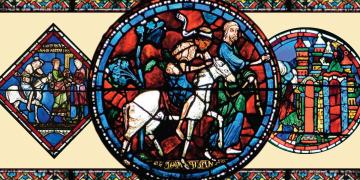You are here
Book of Mormon Central is in the process of migrating to our new Scripture Central website.
We ask for your patience during this transition. Over the coming weeks, all pages of bookofmormoncentral.org will be redirected to their corresponding page on scripturecentral.org, resulting in minimal disruption.
The baptism of Jesus Christ in the New Testament is an immensely important part of Jesus Christ’s life. His baptism marks the beginning of his ministry and is a sign to many of Jesus’s followers that He is the Father’s “beloved son” (Matthew 3:17). But the purpose of baptism, both Jesus’s and his followers’, is left a little vague in the New Testament. What is the purpose of baptism? What is the point of immersing oneself in water? Isn’t believing in Christ enough?
The Book of Mormon clarifies some of the gaps left in the New Testament. It can help followers of Christ understand why it’s important to participate physically in an ordinance like baptism.
Some things the New Testament teaches on baptism
The New Testament offers readers a lot of helpful information about the how and why of baptism. For example, John the Baptist taught that baptism is for the remission of sins and must be preceded by humility and sincere repentance. He taught that candidates for baptism were to bring forth the “fruits” of repentance (Mark 1:4; Matthew 3:8–11; Luke 3:3; Acts 22:15–16). The New Testament teaches that baptism is necessary for entrance into the kingdom of God (John 3:5; 1 Peter 3:21). Baptism represents the death, burial, and resurrection of Jesus Christ (Romans 6:4).
The amazing reason the Book of Mormon gives for baptism
The Book of Mormon provides additional valuable insight into baptism. One of the purposes of the Book of Mormon is to restore plain and precious truths about the Gospel which have been lost or obscured over time. One of these truths is that baptism is a sacred witness and covenant we make before God that we are willing to trust in our Savior and keep his commandments.
Baptism puts believers in the covenant path and is an outward sign of our commitment to Heavenly Father. This doctrine is taught many times throughout the Book of Mormon. For example, Alma taught at the Waters of Mormon that baptism serves “as a witness before [God] that ye have entered into a covenant with him, that ye will serve him and keep his commandments, that he may pour out his Spirit more abundantly upon you” (Mosiah 18:10). Nephi, son of Nephi, also confirmed that baptism acts “as a witness and a testimony before God” (3 Nephi 7:25). To learn more about how the Book of Mormon teaches about baptism, read this KnoWhy.

Image of contract via Adobe Stock. Photography by Maksym Dykha.
Elder Rulen S. Wells uses a fascinating analogy to show how baptism is like a formal contract with God:
“When we enter into a covenant with our fellow men, we draw up an instrument setting forth the obligations and promises of the contracting parties to the covenant. We sign it in our own handwriting, and seal it in the presence of witnesses, and then go before a notary public or a justice of the peace and make an oath to the same. . . When we enter into a covenant with the Lord will it be any less formal or binding on the parties to the covenant? The Lord has made just such a covenant with his children; but does he sign it with pen and ink, or do we subscribe our own handwriting? No! Indeed! The Lord has a much better and more impressive way for us to enter into a covenant with Him.
Baptism by immersion for the remission of sins is the formality of entering into the covenant. We do not need to sign it with pen and ink. We do not need to go before a notary public or a justice of the peace. But when we enter into the waters of baptism, we go in company with a servant of the Lord who has been commissioned of Jesus Christ to perform that sacred ordinance. In performing this ceremony the duly authorized servant of God will take the candidates hands into his left hand, and raise his right hand to the square, saying this: `Having been commissioned of Jesus Christ I baptize you in the name of the Father, and of the Son, and of the Holy Ghost. Amen.’”1
Jesus did not need a remission of his sins because he was already holy and without sin, but by being baptized, he showed his humility and his willingness to follow Heavenly Father, and he made a sacred covenant to do so. He showed us the way by doing what our Heavenly Father asks of all of us (2 Nephi 31:4–11). We follow Jesus and are blessed when we make and keep this sacred covenant to follow the example of Jesus Christ by being baptized.
Related Come Follow Me Resources
- 1. Rulen S. Wells, Conference Report, October 1938, 61.
Subscribe
Get the latest updates on Book of Mormon topics and research for free










